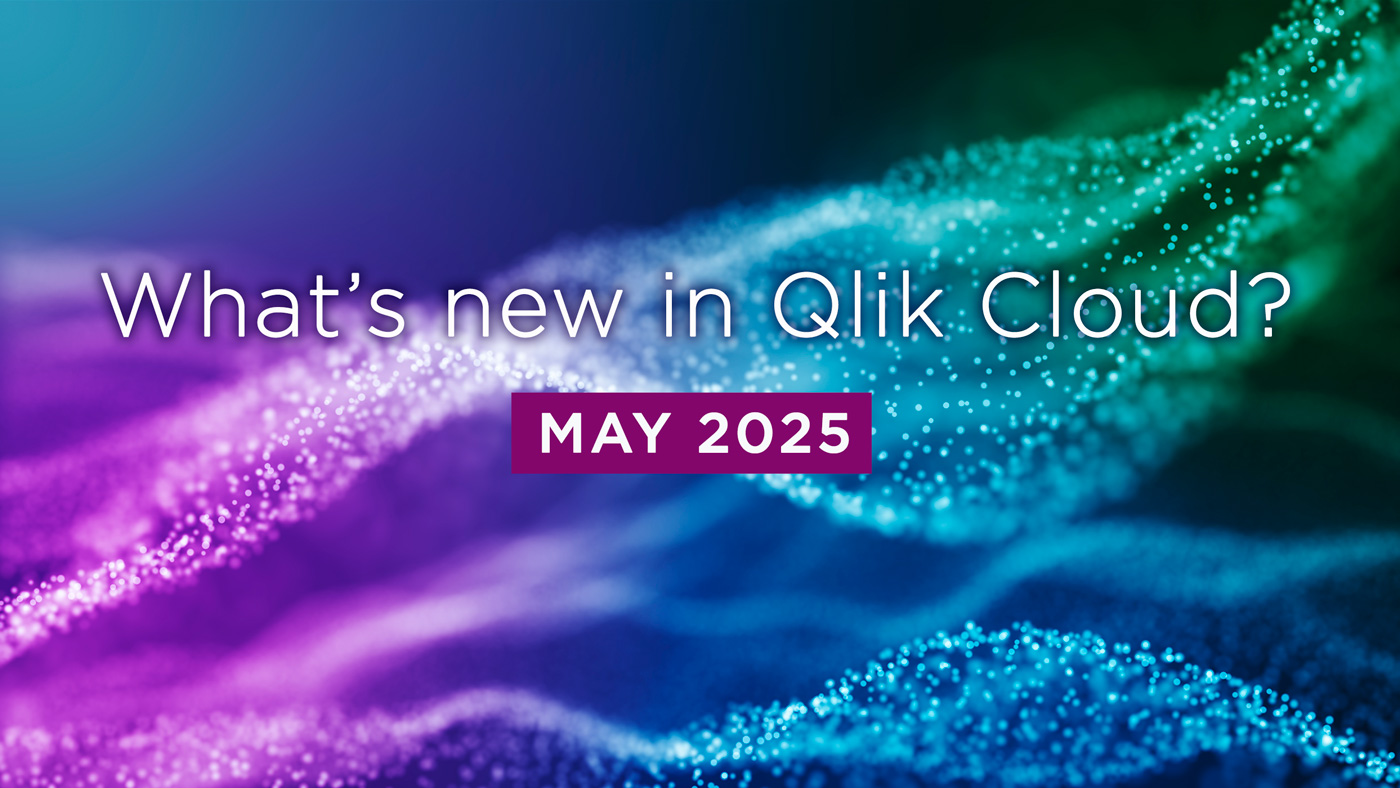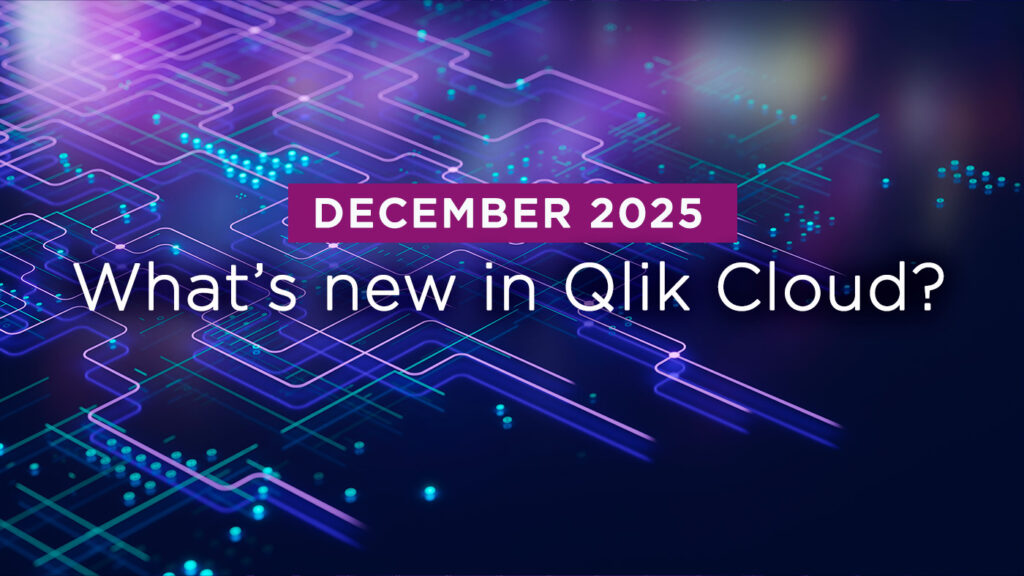
What’s New in Qlik Cloud
– May 2025 Updates –
Welcome to the next edition of the ‘What’s New in Qlik Cloud’ blog for May 2025!
Authors: Roger Gray, BI Manager & Tom Cotterill, BI Consultant, at Climber.
Data Analytics
Welcome to another round of exciting updates from Qlik Cloud! This month brings major enhancements in alerting, visualisation, reporting, AI, data preparation, scripting, plus a big step forward for customers in the Middle East. Let’s dive into what’s new and what it means for you.
1. Alert Execution now based on Real Data Changes
Tired of alerts firing on every reload? Qlik has refined the ”When data is refreshed” condition, now called ”When data changes”. This change ensures alerts only trigger when meaningful updates occur, keeping your inbox signal-heavy and noise-free.
2. Customise Context Menus in Apps
You can now control which actions appear in the right-click menu of your apps via new UI settings. This gives app developers more control over user experience and interaction behaviour.
3. Refresh PixelPerfect Reports with Updated Source Data
If you use PixelPerfect reports, good news! Data binding refreshes just got easier. Now, when your underlying Qlik Sense chart or table is updated with new measures or dimensions, you can refresh the report binding directly, keeping everything in sync without rework.
4. More Flexible Pivot Tables
The latest pivot table version includes powerful usability features:
- Expand and collapse the entire table directly in view mode
- Right-click to expand or collapse individual dimensions
- Full support for right-to-left (RTL) reading orientation
These additions were among the most-requested features from the Qlik community!
5. AI-Powered Assistance now available with Claude Sonnet 3.5
Qlik Answers has been upgraded to use Claude Sonnet 3.5, available in the US (Virginia) and EU (Frankfurt). This enhances the quality of responses, especially for natural language queries and complex analytical tasks.
6. Qlik Cloud Expands to the Middle East
Qlik has announced a new Qlik Cloud region in the United Arab Emirates. This marks their first presence in the Middle East and tenth global region overall.
Benefits include:
- Local data storage for faster access and lower latency
- Improved compliance for finance, healthcare, and government
- Advanced AI support, now closer to where it’s needed most
7. A smarter way to learn: Introducing the new Learn Page
Qlik is reimagining the learning experience with a brand-new Learn page, a step up from the former “Getting Started” section. It’s built to support your growth from onboarding through advanced mastery, offering:
- Outcome-based learning paths
- Trackable progress
- Curated content tailored to real-world use cases
Explore at your own pace and build skills that deliver real impact.
8. Scripting Documentation gets an upgrade
The scripting help now includes improved examples for:
- Inter-record functions
- Conditional logic
- Field functions
This update provides a clearer path for developers looking to get the most from Qlik’s scripting power.
9. Expression Editor gets an upgrade in Data Flow
Writing calculated fields is now more intuitive than ever. The Calculate fields processor includes:
- A guided function and field picker
- Inline syntax hints and links to help documentation
- Useful tools like undo/redo, search and replace, and autocomplete toggle
These features will aid those unfamiliar with the Qlik scripting language to efficiently create more complex data transformations.
10. More power in Data Flow: RegEx, Forks, and Number Conversion
Qlik’s Data Flow just levelled up its no-code data preparation capabilities. Here’s what’s new:
- Advanced string filtering: Use regular expressions and wildcard matching in Filter, Split, and String processors.
- Text-to-number conversion: Seamlessly convert string values to numeric format with a new Numbers processor function.
- Flexible forks: The Fork processor now supports more than two outputs — great for branching logic.
- String overwrite logic: Replace cell values with nulls using the new replace option.
- Clearer math operations: Add, subtract, multiply, and divide are now treated as distinct, user-friendly functions.
11. ML Lineage and Impact Analysis now supported
Machine learning activities, specifically ML Experiments and ML Deployments, are now reflected in Qlik’s Lineage and Impact Analysis views. This applies to new activities created after this release, helping you better understand dependencies and track influence across your analytics ecosystem.
12. Direct Access Gateway 1.7.3: Smarter troubleshooting and better logs
The latest update to Direct Access Gateway brings performance boosts and more transparent diagnostics:
- Logs now include machine metrics (CPU, disk space, memory)
- Timestamps are standardised to UTC (except SAP)
- Process IDs are now included in log messages for the File connector
- Port numbers now appear in file connector log names
Also, unsupported ANSI ODBC drivers are now hidden from the driver list when using ODBC connectors.
13. Major enhancements to Map Charts
Working with map charts just got easier and more flexible:
- Custom selection outlines: Pick your own outline colour to suit your app’s theme
- Improved Web Map Service support: Dedicated fields make setting up Basic Auth for protected WMS services more straightforward

Data Integration
This month, Qlik Data Integration is dishing out a fresh spring menu of updates; light, sharp, and packed with substance. Whether you’re tuning your data quality, tightening governance, or boosting performance in the cloud, there’s something here to refine your flow.
From secure Snowflake views and Databricks pushdown power, to lineage visibility for Talend Studio and spreadsheet-friendly glossary management, it’s all about giving you more control with less friction.
Here’s what’s on the menu!
1. Excel and CSV Support for Glossary Import and Export
Managing business glossaries just got easier. You can now import and export glossaries using Excel or CSV files. This is ideal for teams already maintaining terms and definitions, maybe in shared spreadsheets. This update adds flexibility to the existing JSON-based formats (Qlik, Atlas, and Atlan), making it simpler to bring your glossary into Qlik Cloud or take it with you.
For more information, see Importing and exporting glossaries.
2. Support for Snowflake Secure Views
Support for Snowflake Secure Views, here is one for the Snowflake fans! Qlik Talend Cloud Pipelines now supports Snowflake Secure Views, giving you more control over how data is exposed to end users. You can configure Storage, Transform, and Data Mart tasks to generate secure views, helping you protect sensitive metadata while still delivering the insights users need.
What’s a secure view? In Snowflake, a secure view hides the underlying structure and logic of the view from consumers, ensuring data privacy and shielding your transformation logic from prying eyes. It’s a simple way to keep governance tight without limiting access.
For more information on storing datasets, click here.
3. Talend Studio Jobs now bring full lineage to Qlik Cloud Catalog
Big news for data stewards and governance teams: you can now connect Talend Studio Jobs directly to Qlik Cloud Catalog. This means runtime lineage from Talend Studio is no longer a black box — data consumers get clear, end-to-end visibility from pipeline to product.
Key benefits include:
- Automatic dataset registration from Talend Studio Jobs into Qlik Cloud Catalog
- Field-level lineage tracking, pulled straight into the Catalog
- Data quality scoring and the ability to build data products using Talend-sourced datasets
This seamless integration bridges data integration design and governance, making it faster and easier to deliver trusted, fully traceable data to your users — all in one place.
It’s still not possible to orchestrate or execute Talend Studio Jobs within a QTC pipeline. What you can do is govern, discover, and trust the data those jobs produce as part of the broader Qlik Cloud ecosystem.
Read more:
Publishing datasets and lineage to Qlik Cloud
Understanding your data with catalog tools
4. Data Quality Validation Rules
Say hello to smarter, scalable data quality. With validation rules in Qlik Cloud, you can now define reusable business logic that automatically flags anomalies across your datasets. Whether its ensuring values fall within expected ranges or catching missing entries, these customisable rules help enforce consistent, organisation-wide data standards without manual checks.
More information: Working with validation rules
5. Data Quality Compute Pushdown for Databricks Unity
Qlik Cloud now supports pushdown data quality compute for Databricks Unity, letting you run data validation directly on your Databricks environment. It’s a smarter, more efficient way to scale quality checks, especially for large datasets, while keeping compute costs under control.
Highlights:
- Configurable sample size: Choose how much of your dataset gets validated, by row count or percentage, for fine-tuned control.
- Flexible execution: Run checks within Databricks (pushdown) or use Qlik Cloud’s engine (pullup) depending on your architecture and performance needs.
Read more: Data quality for connection-based datasets

Summary
May brings a strong focus on data governance, quality, and cloud performance. Talend Studio Jobs now integrate directly with Qlik Cloud Catalog, delivering full runtime lineage and field-level traceability. Snowflake Secure Views are now supported in pipelines, giving you better control over data privacy and metadata exposure.
Data quality compute pushdown is now available for Databricks Unity, enabling validation to run where your data lives, boosting performance and optimising resource usage. You can also define reusable validation rules to catch anomalies across datasets. Glossaries can be imported using Excel or CSV, making business term management more accessible to spreadsheet-friendly teams.
Qlik continues to make governed, high-quality data easier to manage, share, and trust.
SUBSCRIBE
Want to stay up to date with the latest features that are released in Qlik Cloud?
Subscribe to our blog and get monthly updates directly to your inbox.
WANT TO KNOW MORE? CONTACT US!
Magnus Petersson-Ahrholt
BI Manager
magnus.petersson-ahrholt@climber.se
+46 70 830 27 35
Thomas Christian
Business Relationship Manager
thomas.christian@climber.se
+46 72 401 47 47
News

Så använder Sveriges största säkerhetsgrossist AI för att stärka kundrelationer
Sveriges största säkerhetsgrossist, Copiax, använder AI-driven analys för att identifiera kunder med vikande köpbeteende – och får insikterna levererade som poddar.
>> Läs mer om projektet här
Qlik Trends 2026
Join us on 14th January for the Qlik streaming event, Powering the Future of AI: Dare to Orchestrate Data, Agents, and Roles. We’ll reveal and explore the three key areas that successful enterprises must wire together to ensure integrity, connect every system seamlessly, and fuel innovation at the edge.
>> REGISTER NOW
What’s New in Qlik Cloud – December 2025
December brings a wide range of updates across Qlik Cloud Analytics, Qlik Automate, and platform administration. Qlik has also left some releases under the tree for the data integration pros.
>> Read more
